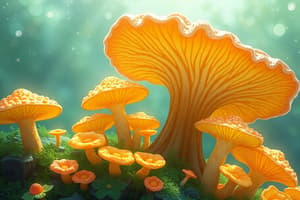Podcast
Questions and Answers
What is a characteristic feature of multicellular algae mentioned?
What is a characteristic feature of multicellular algae mentioned?
- They are typically ribbon-like in form. (correct)
- They are always unicellular.
- They are generally spherical in shape.
- They exclusively grow underwater.
Which of the following is an example of unicellular algae?
Which of the following is an example of unicellular algae?
- Spirogyra
- Chlamydomonas (correct)
- Ulothrix
- Volvox
In what environments can certain forms of algae be found?
In what environments can certain forms of algae be found?
- In dry desert sands
- On tree bark, rocks, and moist soil (correct)
- Only in marine environments
- Only in freshwater lakes
How are the different types of algae categorized based on cellular structure?
How are the different types of algae categorized based on cellular structure?
What distinguishes multicellular algae from unicellular forms?
What distinguishes multicellular algae from unicellular forms?
What role does chlorophyll play in the survival of red seaweed?
What role does chlorophyll play in the survival of red seaweed?
In what type of conditions can red seaweed thrive?
In what type of conditions can red seaweed thrive?
Which statement best describes the relationship between red pigments and chlorophyll in red seaweed?
Which statement best describes the relationship between red pigments and chlorophyll in red seaweed?
Which of the following characteristics are typical of gymnosperms?
Which of the following characteristics are typical of gymnosperms?
What is a primary survival strategy of red seaweed?
What is a primary survival strategy of red seaweed?
Which of the following correctly identifies a class of gymnosperms?
Which of the following correctly identifies a class of gymnosperms?
What distinguishes red seaweed from other types of seaweed regarding light absorption?
What distinguishes red seaweed from other types of seaweed regarding light absorption?
What type of plants are gymnosperms classified as, based on their environmental adaptations?
What type of plants are gymnosperms classified as, based on their environmental adaptations?
What is a defining feature of the embryo in gymnosperms?
What is a defining feature of the embryo in gymnosperms?
How many species of plants are classified as gymnosperms?
How many species of plants are classified as gymnosperms?
What is one of the forms in which economic utilities are commonly used?
What is one of the forms in which economic utilities are commonly used?
Which of the following is NOT mentioned as a use of economic utilities?
Which of the following is NOT mentioned as a use of economic utilities?
In what way are economic utilities used regarding decorative and domestic purposes?
In what way are economic utilities used regarding decorative and domestic purposes?
Which of the following materials is NOT associated with economic utilities?
Which of the following materials is NOT associated with economic utilities?
How are economic utilities used in relation to wellness?
How are economic utilities used in relation to wellness?
Which characteristic is commonly associated with monocots?
Which characteristic is commonly associated with monocots?
Which of the following examples belongs to monocots?
Which of the following examples belongs to monocots?
What is the number of cotyledons found in the seeds of monocot plants?
What is the number of cotyledons found in the seeds of monocot plants?
Which of the following is NOT a characteristic of monocots?
Which of the following is NOT a characteristic of monocots?
Which of the following plants is classified as a monocot?
Which of the following plants is classified as a monocot?
Flashcards are hidden until you start studying
Study Notes
Algae
- Some algae grow on trees, rocks and moist soil.
- Algae can be unicellular (one cell) or multicellular (many cells).
- Multicellular algae are usually ribbon-like.
- Examples of algae include Chlamydomonas (unicellular) and Ulothrix.
- Red pigments in algae absorb light, but chlorophyll is needed to process it.
- This allows red seaweed to survive in low-light conditions.
Gymnosperms
- Gymnosperms include shrubs and woody trees.
- Examples include Ephedra, Pinus, Abies, Ginkgo, Gnetum.
- Gymnosperms have 4 classes and about 861 species.
Gymnosperm Characteristics
- These plants are perennial (live for many years) and xerophytic (adapted to dry environments).
- They are pollinated by wind.
- They have one or more cotyledons (seed leaves) in their embryos.
- Economic uses of gymnosperms include food, timber, medicine, decoration, and making volatile oils, tanning materials, and resins.
Monocots
- Monocot stems lack cambium (a layer of cells that allows stems to grow thicker).
- Examples of monocots include maize, wheat, rice, onion, sugarcane, barley, banana, and coconut.
Monocot characteristics
- Monocot seeds contain one cotyledon.
- Monocot leaves have parallel venation (veins run parallel to each other).
Studying That Suits You
Use AI to generate personalized quizzes and flashcards to suit your learning preferences.



